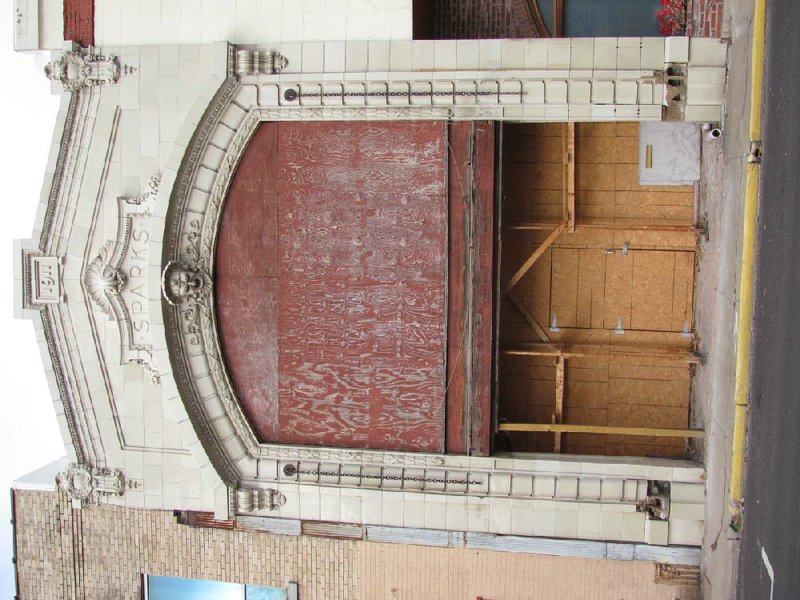FORT SMITH — Plans to restore the carriage entrance of the New Theatre aim to recreate the elegance of a building that has lain dormant on downtown’s 10th Street since the late 1970s.
The theater’s owner, Fort Smith developer Richard Griffin, received permission last week from the Central Business Improvement District, for which he serves as chairman, to perform the renovation work.
The project will consist of replacing broken tile on the ornate terra cotta arch that surrounds the entry, the canopy that once hung over the entrance and the glasswork and doors under the arch, Griffin said.
The archway is mostly intact, but plywood boards cover the area under the arch. Griffin said he’s glad to have an opportunity to make improvements to what he said has become “an eyesore on 10th Street.”
The replacement tile is being produced by local artist Peter Lippincott, Griffin said. Getting the color of the original tile just right was difficult, he said.
Also, a new metal canopy will have some of the filigree ornamentation that was on the theater originally, Griffin said.
The renovation work will take about six months to complete, Griffin said. He wouldn’t reveal the cost but said it would be paid for by the Griffin family’s charitable foundation.
Griffin, a local-history buff, said he would like to renovate the entire theater, but the cost is an obstacle. Renovating the box-office area just inside the entry is a possible next step, but Griffin hasn’t yet committed to that. Finishing the entire theater renovation is on his “bucket list.”
So far, the only work that has been done on the theater is the replacement of the roof to prevent further deterioration.
The theater was added to the National Register of Historic Places in 1999, according to the register’s website.
Griffin said he decided to restore the carriage entrance after local amateur historian Joe Wasson showed him a photograph of the old entrance taken by a vaudeville troupe that appeared there in April 1912. Wasson said the theater had been open only a few months when the photo was taken.
Wasson said he bought the photograph and others that were part of an album of photographs being sold on eBay. The amount of photographs in the album suggest that the troupe took photographs of most of the theaters where it performed around the country, Wasson said.
Griffin said having a copy of the photograph gave him a good idea of what the entrance actually looked like to help with the renovation.
The theater is a replica of the New Amsterdam Theater in New York City, which First National Bank founder George Sparks visited in 1903, Griffin said. The lavish theater in Fort Smith had two balconies, an orchestra pit and opera boxes on either side of the stage, he said.
The opera boxes were removed when the theater was converted to a movie theater in the 1940s to accommodate the rudimentary air-conditioning system of the day, Griffin said.
Research done in the 1990s by students at Westark Community College (now the University of Arkansas at Fort Smith) showed the theater had a variety of events, Wasson said.
On opening night, Sept. 30, 1911, the first shows were Lou Dock Stader’s Minstrels and the play The Third Degree.
Admission on the first night was $10, Wasson said, an unusually expensive amount only the richest residents in Fort Smith could have afforded. Normal admission in those early days was a nickel and a dime, he said.
Other events at the theaterwere vaudeville shows, plays, boxing matches, a women’s rally in 1913, church services, and appearances by preachers and lecturers.
Early silent movies began playing around 1914, Wasson said. He said one of the theater’s curtains had a large white square onto which the movies were projected.
Percy Darby, father of Fort Smith’s World War II hero William O. Darby, was the leader of the small band that played in the orchestra pit and provided the sound for the silent movies. The band eventually was replaced by an organ, Wasson said.
Malco Theaters leased the theater from the Sparks family in 1942, Wasson said, and ran it as a movie theater until it closed in 1978. Griffin bought the building in 2004.
Arkansas, Pages 7 on 12/24/2012
